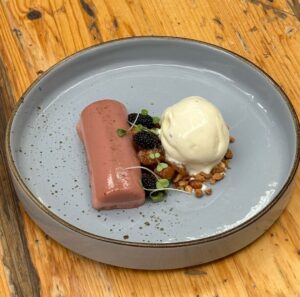MasterChef Rohit Chidurala is not just a chef; he’s a culinary storyteller, weaving tales of flavor, tradition, and innovation through his exquisite dishes. His journey into the world of gastronomy began unexpectedly, sparked by a chance encounter with auditions for MasterChef India Telugu. What started as a leap of faith soon catapulted Rohit into a realm of culinary exploration and discovery.
Throughout his MasterChef journey, Rohit’s dishes captivated judges and audiences alike, earning him a spot among the top 10 contestants. But beyond the competition, it was the shared camaraderie among contestants and the invaluable lessons from esteemed chef judges that truly enriched his experience.

Rohit’s culinary philosophy is deeply rooted in the appreciation of diverse culinary practices and the preservation of cultural identities. He believes in the power of food to transcend boundaries, foster community, and celebrate heritage. Whether it’s reviving ancient recipes or innovating with fusion cuisine, Rohit’s creations reflect a harmonious blend of tradition and modernity.
Drawing inspiration from his Telugu heritage, Rohit celebrates the vibrant flavors and spices that define the region’s cuisine. His mastery of masala blends and traditional cooking techniques pays homage to generations of culinary wisdom while infusing his dishes with a contemporary flair.
In every dish he creates, Rohit strives to evoke not just taste but also emotion, inviting diners on a sensory journey of discovery. With each bite, he invites you to savor the rich tapestry of flavors, textures, and aromas that tell the story of his culinary journey.
When did you start your journey as a MasterChef?
My journey to becoming a MasterChef contestant began unexpectedly while I was at my ROCH Cake Studio. I
noticed a social media post about auditions for MasterChef India Telugu and decided to apply for the experience.
Encouraged by my sister, who said, “Give it a shot. If you get selected, that’s great; if not, no problem,” I took a leap
of faith.
This decision launched an incredible culinary adventure. During the auditions, my dishes impressed the
judges, propelling me through the rounds until I reached the top 10—a monumental achievement in my life.
Throughout this journey, my co-contestants became like an extended family, and the chef judges imparted
numerous valuable lessons.
Their guidance and the camaraderie among contestants enriched the experience,
making it not just a competition, but a life-enhancing journey filled with shared passions and discoveries. This
experience tested my skills, deepened my culinary passion, and provided a platform to showcase my talents to the
world.
How do we differentiate between appreciating and appropriating culinary practices?
Appreciating culinary practices involves respecting and learning about the origins of different foods. For instance,
the revival of millets in India highlights this appreciation. Recognized for their health and environmental benefits,
millets were celebrated globally when the United Nations declared 2023 as the International Year of Millets,
underscoring their importance in sustainable agriculture.
Another example of appreciation is when chefs from different cultures learn traditional cooking methods directly
from their originators and share these dishes with appropriate credit. This approach respects the tradition and
educates others authentically.
Conversely, appropriation occurs when cultural dishes are adapted in ways that strip away their original meaning
or fail to acknowledge their origins. For example, a restaurant might alter a traditional dish to suit local tastes
without explaining its cultural significance, which can be seen as cultural appropriation.
Appreciation is crucial as it promotes mutual respect and understanding among diverse cultures. It helps preserve
traditional knowledge and practices at risk of being lost in a globalized world.
By valuing appreciation over appropriation, we contribute to a richer, more diverse global culture where the heritage of all communities is acknowledged and valued.
In what ways do traditional dishes and food rituals contribute to the preservation of cultural identity in a globalized world by MasterChef Rohit Chidurala
Traditional dishes and food rituals are vital in preserving cultural identity, especially as global boundaries blur.
Food transcends mere sustenance, embodying a culture’s history, traditions, and values.
Cultural Heritage and Continuity: Traditional recipes passed down through generations act as a living archive of
cultural history. For instance, the preparation of mole sauce in Mexico during special occasions not only preserves
ancient culinary practices but also unites communities around their shared heritage.
Sense of Community and Belonging: Food rituals, such as the Japanese tea ceremony or American Thanksgiving
dinner, reinforce community bonds and a shared sense of identity. These rituals embody specific practices that
strengthen social ties among participants.

Resilience Against Cultural Homogenization: Amidst the spread of fast food and Western diets, maintaining traditional culinary practices helps preserve unique cultural identities, allowing communities to retain their
distinctive traditions in a rapidly changing world.
Economic and Social Value: Traditional cuisines can also drive economic benefits through tourism. Culinary tourism, as seen in Italy and Thailand, promotes the preservation and revival of local practices and ingredients,
offering authentic experiences that attract visitors.
Educational Tool: Culinary festivals, cooking classes, and media focused on traditional cuisines educate people about the origins, techniques, and importance of different dishes, enhancing understanding and appreciation.
Together, these elements help maintain global cultural diversity, highlighting food’s role as a potent tool in preserving cultural identities.
How has colonial history influenced the culinary practices and food preferences in
various parts of the world?
Colonial history profoundly shaped culinary practices worldwide, merging indigenous traditions with foreign
influences to forge new gastronomic landscapes.
The Columbian Exchange exemplified this, as foods like tomatoes and potatoes from the Americas became global staples, while European imports like wheat and sugar transformed diets elsewhere.
Colonialism birthed fusion cuisines, such as Anglo-Indian fare in India and blended Caribbean dishes, marrying
local spices and techniques with European tastes.
Agricultural shifts prioritized cash crops over local foods, reshaping diets and economies. The focus on crops like sugar and tea drove economic and social shifts, impacting food availability and culinary customs.
Colonial dining norms persisted post-independence, reflecting the enduring impact of colonization on culinary
etiquettes. This complex legacy intertwines cultural exchange with the dark shadow of conquest, yielding beloved
dishes amidst a history of oppression and adaptation.
What defines successful fusion cuisine, and what are some of the most innovative
examples you’ve encountered?
Key aspects of successful fusion cuisine in India include:
1. Flavor Fusion: Fusion dishes should seamlessly integrate Indian spices and flavors with those from other
cuisines, creating a harmonious balance that enhances the overall dining experience.
2. Cultural Sensitivity: Fusion cuisine in India should respect the cultural origins of both Indian and foreign
ingredients and techniques, avoiding misappropriation or disrespect.
3. Innovation with Authenticity: While fusion cuisine allows for creativity, successful dishes should still maintain a
connection to authentic Indian culinary traditions, ensuring that the essence of Indian cuisine is preserved.
4. Regional Inspiration: Drawing inspiration from the diverse regional cuisines of India can further enrich fusion
dishes, adding depth and complexity to the flavor profiles. Innovative examples of successful fusion cuisine in India may include dishes like butter chicken pizza, masala
pasta, tandoori tacos, or Indo-Chinese noodles. These dishes combine Indian spices and ingredients with elements
from Western or Chinese cuisines, resulting in unique and flavorful creations that pay homage to both Indian
culinary traditions and global influences.
How have historical trade routes and regional interactions influenced the development
of masala blends specific to Telugu cuisine?
Historical trade routes have significantly influenced Telugu cuisine, particularly in the development of its
distinctive masala blends. The strategic position of the Telugu-speaking regions along ancient trade routes, such as
those linking the Eastern Ghats with other parts of the Indian subcontinent and beyond, has facilitated a rich
exchange of spices and culinary techniques.
Introduction of Spices: Telugu cuisine has greatly benefited from the trade of spices such as turmeric, cardamom,
and black pepper. These spices, whether locally grown or imported from other parts of India and Southeast Asia,
are fundamental to the rich and robust flavors characteristic of Telugu masalas.
Influence of Foreign Traders: Historically, traders from the Middle East, Central Asia, and later Europe have
traversed the Indian subcontinent, reaching the Telugu regions. Their influence is evident in the incorporation of
saffron and nuts into Telugu dishes, adding luxurious flavors and textures.

Regional Interaction: Interactions within India have also shaped Telugu cuisine. Ingredients like tamarind and red
chilies, staples in South Indian kitchens, have been seamlessly integrated into Telugu cooking, adding complexity
and depth to its masala blends.
Culinary Innovation: The availability of a diverse array of ingredients has spurred culinary innovation, leading to
the creation of unique masala blends that are distinct to Telugu cuisine. These blends typically combine the heat from chilies, the earthiness of turmeric, and the sweetness of spices like cinnamon or cloves, reflecting the region’s long history of spice trade and culinary amalgamation.
What distinguishes Telugu masalas from other regional Indian spice blends in terms of ingredients and preparation methods?
Telugu masalas, integral to the cuisine of Andhra Pradesh and Telangana, are known for their bold flavors and often fiery heat. This distinctiveness arises from both the ingredients used and the methods of preparation. Here are some key factors that set Telugu masalas apart:
1. Use of Red Chilies: Telugu cuisine is renowned for its liberal use of red chilies, making it one of the spiciest in
India. The specific type of chili, such as Guntur red chili, adds a deep color and intense heat that is characteristic of
Telugu dishes.
2. Tamarind Incorporation: Another hallmark is the use of tamarind, which provides a tangy flavor that balances
the heat of the chilies. This sour note is more pronounced in Telugu cuisine than in many other regional Indian
cuisines.
3. Roasting of Spices: The preparation method often involves roasting spices before grinding them, which enhances
their aroma and depth of flavor. This technique is particularly prevalent in the making of masalas like Goda Masala,
commonly used in Telugu cuisine.
4. Unique Spice Blends: Telugu masalas might include spices not commonly used in other regional blends, such as
poppy seeds, curry leaves, and fenugreek seeds, which contribute to their unique flavor profiles.
These ingredients and methods contribute to the robust and vibrant flavors that define Telugu cuisine, setting it
apart from other Indian culinary traditions.
What are some of the health benefits associated with commonly used spices in Telugu
cuisine?
Telugu cuisine, known for its rich and vibrant flavors, incorporates a variety of spices that not only enhance the
taste but also offer numerous health benefits. Here are some commonly used spices and their benefits:
1. Turmeric: A staple in Telugu cooking, turmeric is renowned for its anti-inflammatory and antioxidant properties.
It contains curcumin, which helps reduce inflammation and can aid in pain relief and improving skin health.
2. Fenugreek: Often used in tempering dishes, fenugreek seeds are beneficial for controlling blood sugar levels and
improving digestive health. They are also considered beneficial for lactating mothers.
3. Mustard Seeds: Used in many Telugu dishes for tempering, mustard seeds can enhance digestion and circulation.
They are also known for their antibacterial properties.
4. Cumin: Cumin seeds, used both whole and ground, are good for digestion, help in curing respiratory issues, and
have anti-carcinogenic properties.
5. Chilies: Red chilies are abundant in Telugu cuisine. Capsaicin, the compound that gives chilies their heat, is
known for its pain-relieving properties and ability to reduce inflammation.
6. Coriander: Widely used in Telugu dishes, coriander is beneficial for digestive health, has anti-inflammatory
properties, and can help lower blood sugar levels.
These spices reflect Telugu cuisine’s holistic approach to health, where food is not just nourishment but also
medicine, aligning with the Ayurvedic principle that emphasizes the healing properties of foods and spices. This
connection between diet and wellness is a core aspect of the region’s culinary philosophy.
How do masala blends vary between the different regions of Andhra Pradesh and
Telangana?
The diversity in masala blends across Andhra Pradesh and Telangana is influenced by various geographical,
climatic, and cultural factors. Here’s how these factors contribute to the regional variations:
1. Geographical and Climatic Influence: Andhra Pradesh, with its coastal plains, fertile river deltas, and hilly
terrains, grows a variety of spices that influence local masala blends.
The coastal regions, for example, use more coconut and mustard seeds in their blends, suitable for seafood dishes. In contrast, the more arid regions of Telangana might rely more on millet-based ingredients and robust spices that are well-suited to
preserving foods in hotter climates.

2. Cultural Variations: Cultural preferences also dictate spice use. For instance, Telangana cuisine tends to be more influenced by Central Indian and Deccani culinary styles, featuring nuttier and creamier textures, whereas Andhra cuisine often emphasizes tanginess and heat, making extensive use of tamarind and red chilies.
3. Historical Influences: The historical influence of various dynasties, including the Vijayanagara Empire and the Mughals, has also left an imprint on the regional cuisines, reflected in the spice mixes used.
For example, the use of Persian spices like saffron and nuts in certain Telangana dishes can be traced back to Mughal influences. These factors make each region’s cuisine distinct, with masala blends uniquely tailored to complement the local ingredients and dietary preferences, reflecting the rich culinary tapestry of the states.
What is your favorite dish that you always try?
Your favorite dish, masala pappu with tomato chutney and salla chaaru served with rice, superbly captures the essence of Telugu cuisine. Masala pappu, a hearty dish made with lentils and a rich blend of spices, offers deep,
savory flavors. When paired with the tangy and robust tomato chutney, it creates a delightful interplay of tastes.
Complementing this duo, salla chaaru, a tangy soup similar to rasam, adds a soothing and aromatic layer to the
meal. This combination is not just comforting but deeply entrenched in the culinary traditions of Telugu cuisine,
celebrating the region’s love for bold flavors and wholesome meals.
This dish exemplifies the traditional flavors and homestyle cooking that are close to your heart, making it a perfect representation of your culinary preferences and heritage.























